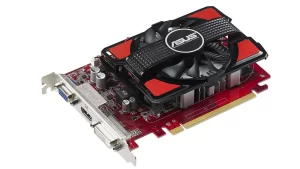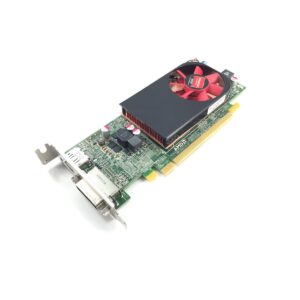The AMD Radeon R7 250 happens to be the most affordable AMD GPU. Indeed, it possesses the capability to play modern games at 1920×1080 at reasonable detail levels. In fact, the AMD Radeon R7 250 can also draw all the power it needs from the PCI Express socket. Therefore, it does not require an extra PCI Express power connector.
Thus, the R7 250 comes across as an entry-level Radeon card that does not need extra power connections to function. Hence, you can just plug into a PCI Express x16 bus socket and you are good to go. Indeed, this makes it suitable for use in PCs with basic power supplies that lack PCI Express power connectors. As for display outputs, the R7 250 offers HDMI, DVI, and VGA connections. Therefore, you should not face any trouble connecting the card to your display.
The R7 250’s graphics processor offers 384 stream processors and operates at a clock speed of 1.050GHz. The graphics processor is coupled with 1GB of graphics memory operating at 1.15GHz. Thus, this is not an especially impressive specification. However, this is not too poor either if you just intend to lay your hands upon a general-purpose graphics card and do not intend to play games at optimal quality.
Indeed, the R7 250 offered an average frame rate of only 27.1fps in the Dirt Showdown test at a resolution of 1920×1080. The graphics quality was maintained at Ultra. Thus, it ranges too low for truly smooth gameplay. However, bringing down the graphics to High accelerated the average frame rate to a much smooth and far more playable 47 fps.
In fact, when it came to Crysis 3, reducing the graphics quality to Medium only increased the average frame rate to 17.6fps. However when we brought down the resolution to 1280×720 and graphics quality to Medium, thr R7 250 offered a much smoother frame rate of 31.3fps.

Technical specifications
The Radeon R7 250 comes across as an entry-level graphics card by AMD. It saw the light of the day on October 8th, 2013. Formed on the 28 nm process, and developed on the Oland graphics processor, in its Oland XT variant, the card holds up DirectX 12. However, although it bears DirectX 12, the feature level is only 11_1. Thus, this can prove to be a problem with newer DirectX 12 titles. The Oland graphics processor happens to be a comparatively small chip with a die area of only 77 millimeter square and 950 million transistors.
It comes with 384 shading units, 24 texture mapping units, and 8 ROPs. AMD has combined 1,024 MB GDDR5 memory with the Radeon R7 250. These are in turn linked using a 128-bit memory interface. The GPU functions at a frequency of 1000 MHz. Indeed, you can boost that up to 1050 MHz. The memory is operating at 1150 MHz (4.6 Gbps effective).
Being a dual-slot card, the AMD Radeon R7 250 does not need any extra power connector. Its power draw ranges at 65 W maximum. Radeon R7 250 is linked to the rest of the system using a PCI-Express 3.0 x8 interface. During launch its price was 89 US Dollars. The AMD Radeon R7 250 shares compatibility with crossfire technology. Indeed, if you pair it with another graphics card then it will perform far better in games.

Performance
If we talk about game and settings, the performance of the Radeon R7 250 is identical with the Nvidia GeForce GTX 650. Therefore, the card shares the same level or standard with the fast mid-range GPUs of the notebook segment, for instance the GeForce GT 755M. Indeed, you can play 2013’s recent games fluently in 1366×768 pixels at medium or high settings. In some older or less challenging games, higher resolutions or extra AA/AF are possible.
Other details
The R7 250 holds up features like Eyefinity (max. 2 displays). It also supports some innovations such as a new turbo mode. Depending on power consumption and temperature, you can boost the core up to 1050 MHz. Indeed, the R7 250 is very energy efficient when it’s out of action. The credit certainly goes to dynamic clock adjustments and the Zero Core technology.
Also read: Here Is Everything You Need To Know About AMD Radeon R9 380x
